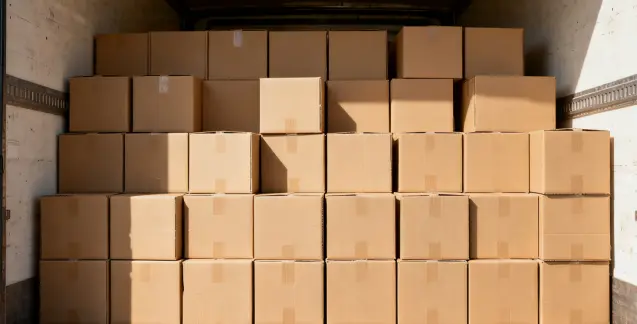For businesses across e-commerce, retail, and manufacturing, shipping costs have emerged as a silent profit e-roder. Carrier rate hikes, dimensional weight pricing, and fuel surcharges can chip away at margins—often without brands realizing the root cause lies in their packaging. As your dedicated packaging supplier, we don’t just provide materials; we engineer solutions that turn packaging into a cost-saving tool. Below are 8 actionable strategies, each refined through years of partnering with clients to cut logistics expenses while maintaining product safety and brand standards.
1.Shipping CostsHigh? We Cut Them with Smart Packaging
If you’re tired of watching shipping invoices eat into profits, smart packaging is your first line of defense. Many businesses fall into the “one-size-fits-all” trap, using boxes that are far larger than needed or over stuffing packages with excessive padding—both of which drive up dimensional weight charges (carriers calculate cost based on space as much as weight).
Our process starts with a free packaging audit: recently, a client selling small Bluetooth speakers was using 12x10x8-inch boxes for a product that only required a 6x4x3-inch container. By swapping to our custom-fitted boxes with minimal, shock-absorbent paper padding, we reduced their per-shipment cost by $3.80. For their 12,000 monthly orders, that translated to a $45,600 monthly savings. We also prioritize lightweight, high-strength materials: instead of EVA, we use foam fill that’s 30% lighter and just as protective. Smart packaging isn’t about cutting corners—it’s about matching materials to your product’s exact needs, and we’re here to make that precision simple and affordable.

2.Custom Packaging Size/Weight = Lower Shipping Costs
Dimensional weight fees are the single biggest hidden cost in shipping, and generic packaging is their enabler. When you use a box that’s too big, you’re paying for air—and carriers charge premium rates for that wasted space. Our custom packaging solves this by tailoring size and weight to your product’s dimensions.
Take a client who sells artisanal soap bars: they previously used 8x6x4-inch boxes for 3x2x1-inch soaps, leading to charges that made up 40% of their shipping cost. We designed a slim, custom foldable box that fits 4 soaps perfectly, cutting the package’s volume by 55%. The result? Shipping dropped by 38%, and their total shipping cost per order fell from $5.20 to $3.25. We also optimize weight: for clothing brands, we use ultra-thin (but tear-resistant) poly mailers that weigh 0.2 ounces less than standard mailers. For a brand shipping 50,000 orders monthly, that’s 625 pounds in weight savings—translating to $2,100 in lower carrier fees. Custom packaging isn’t a luxury; it’s a necessity for anyone serious about slashing shipping costs.

3.Sustainable Packaging: Save Money + Go Green
Sustainability and cost savings don’t conflict—they complement each other, and we prove it with every client. Many businesses assume “eco-friendly” packaging costs more, but our swaps often reduce both expenses and environmental impact.
A client in the organic snack industry was using single-use plastic bubble wrap to protect their products. We recommended switching to recycled paper void fill: it’s 22% cheaper than plastic, weighs 15% less (lowering shipping weight), and aligns with their brand’s eco-values. After the swap, their customer surveys showed a 17% increase in repeat purchases, driven by the sustainable packaging. Another example: a B2B client shipping industrial parts replaced wooden pallets with our reusable corrugated boxs. Going green doesn’t have to break the bank—we help you choose sustainable materials that save money while strengthening your brand.

4.We Recommend Logistics-Friendly Packaging
Your packaging only works if it plays nice with your shipping carriers and logistics partners. A package that’s hard to stack, doesn’t fit carrier sorting systems, or violates weight guidelines will lead to unexpected surcharges and delays. As your supplier, we design packaging with logistics in mind.
Logistics-friendly packaging prioritizes compatibility with carrier operations, starting with shape optimization. We focus on regular, stackable designs—such as square or rectangular forms—that fit seamlessly into carrier trucks, warehouses, and sorting machines, eliminating wasted space and reducing the risk of packages shifting during transit. We also tailor packaging strength to match both product weight and carrier handling standards: for heavier items, we integrate reinforced structures (like reinforced corners or double-walled materials) to meet carrier weight thresholds, while for lighter goods, we use lightweight yet durable materials to avoid unnecessary bulk.

Beyond form and strength, we align packaging with carrier-specific rules to prevent surcharges. This includes adhering to each carrier’s limits on dimensions (such as length, width, and height for overnight or expedited shipping), weight restrictions, and labeling requirements. We also ensure packaging is easy to handle—with smooth edges, clear labeling, and appropriate sizing for automated sorting systems—to speed up processing at carrier facilities and minimize delays. By designing packaging that works in tandem with your supply chain, we help you avoid extra fees, reduce transit time, and maintain consistent delivery reliability.
5.One-Stop Packaging: Streamline Your Processes
Inefficient packaging procurement—ordering boxes from one vendor, padding from another, and labels from a third—wastes time, money, and energy. A one-stop packaging solution eliminates these headaches by centralizing all your needs with a single supplier.
A one-stop packaging service consolidates every aspect of your packaging procurement into a unified process, covering all essential materials from primary containers (like boxes, mailers, and crates) to secondary items (such as padding, void fill, and protective inserts) and finishing supplies (including labels, tape, and sealing tools). This centralization eliminates the need to manage multiple vendor relationships, coordinate separate delivery schedules, and reconcile disjointed invoices—tasks that often consume hours of administrative time and create room for error.
Beyond simplifying ordering, one-stop solutions include proactive inventory management to prevent disruptions. We monitor your packaging usage patterns in real time, tracking how quickly each material is 消耗 (consumed) and setting automatic reorder triggers to replenish stock before it runs low. This avoids the risk of stockouts that force last-minute rush orders (and their associated premium fees) or pause fulfillment operations. We also ensure material compatibility: every component (from box size to padding thickness) is curated to work together, eliminating issues like mismatched dimensions or incompatible protective materials that waste resources and compromise product safety. By streamlining procurement and inventory, one-stop packaging turns a fragmented process into a cost-efficient system that saves time, reduces waste, and keeps your operations running smoothly.
6.Analytics-Driven Packaging for Cost Savings
Guesswork in packaging design costs money—we use data to ensure every decision delivers savings. Our analytics process starts with reviewing your shipping history: we analyze order volumes, product dimensions, carrier rates, and damage reports to identify inefficiencies.
For a toy brand, we found that 75% of their orders were for small plush toys, but they were using the same large boxes as their bigger products. Using this data, we designed a 3-tier packaging system: small boxes for plush toys, medium for action figures, and large for playsets. This cut their average package volume by 40% and DIM charges by 33%. We also track carrier rate changes in real time: when a major carrier raised weight-based fees earlier this year, we used analytics to recommend switching to lighter corrugated board for non-fragile items, offsetting the rate hike by 28%. Analytics turn vague assumptions into concrete savings—we don’t just guess what works; we prove it with data.

7.Bulk Packaging with Us = Lower Logistics Bills
Bulk ordering with your packaging supplier isn’t just about getting more materials—it’s about unlocking shared cost savings. We pass on volume discounts to clients who commit to larger orders, and we pair that with logistical perks that cut even more expenses.
Our “direct-to-3PL” delivery further trims logistics bills: instead of shipping packaging to your warehouse first (where you’d pay for unloading, storage, and re-shipping), we send orders directly to your third-party logistics provider. This removes a supply chain step, cutting in-house labor costs for handling and inventory management while reducing damage risks from multiple transfers.
Bulk ordering is about strategic planning, not just buying more. We help you balance inventory needs with cost savings to get the best of both worlds.
8.Dynamic Packaging for Real-Time Rate Changes
Shipping rates don’t stay static—carriers adjust fees seasonally, during peak periods (like holidays), or due to fuel costs. Your packaging needs to adapt to these changes, and we make that easy with dynamic solutions.
When carriers raise dimensional weight or fuel-related fees, we optimize packaging design to offset cost increases: we slim down box dimensions (while maintaining product protection) and switch to lighter-weight materials (like low-density but durable tapes or inserts) to reduce overall package weight and size, ensuring shipping costs don’t rise with carrier rate hikes.
For seasonal peaks, we offer collapsible packaging options: these are shipped flat to your warehouse to save up to 70% on storage space, then expanded only when needed for order fulfillment. This cuts bulk shipping costs for packaging itself by 40% during high-demand periods, as flat packaging reduces transit volume and associated fees.
We also proactively monitor carrier promotions—such as reduced rates for lightweight or standardized-size packages—and adjust your packaging (like switching to thinner, strength-rated mailers) to qualify for these discounts. Dynamic packaging means you’re never caught off guard by rate changes—we keep your packaging optimized, no matter the market shifts.
Choosing us will enable us to offer you the most suitable packaging solution. Please feel free to contact us at any time.
Post time: Oct-29-2025



